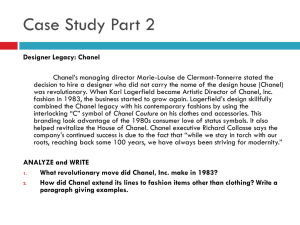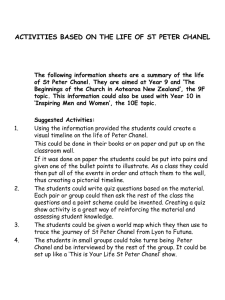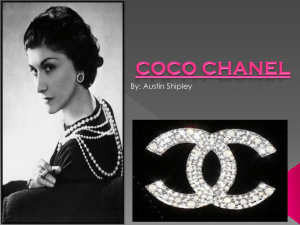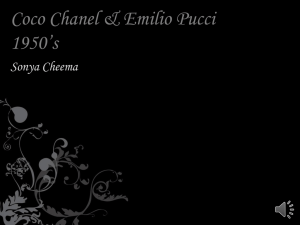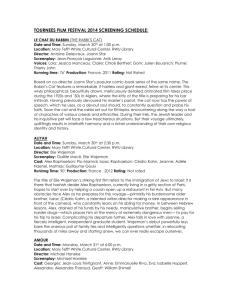Luxury Strategy of Beauty Products by Chanel
advertisement
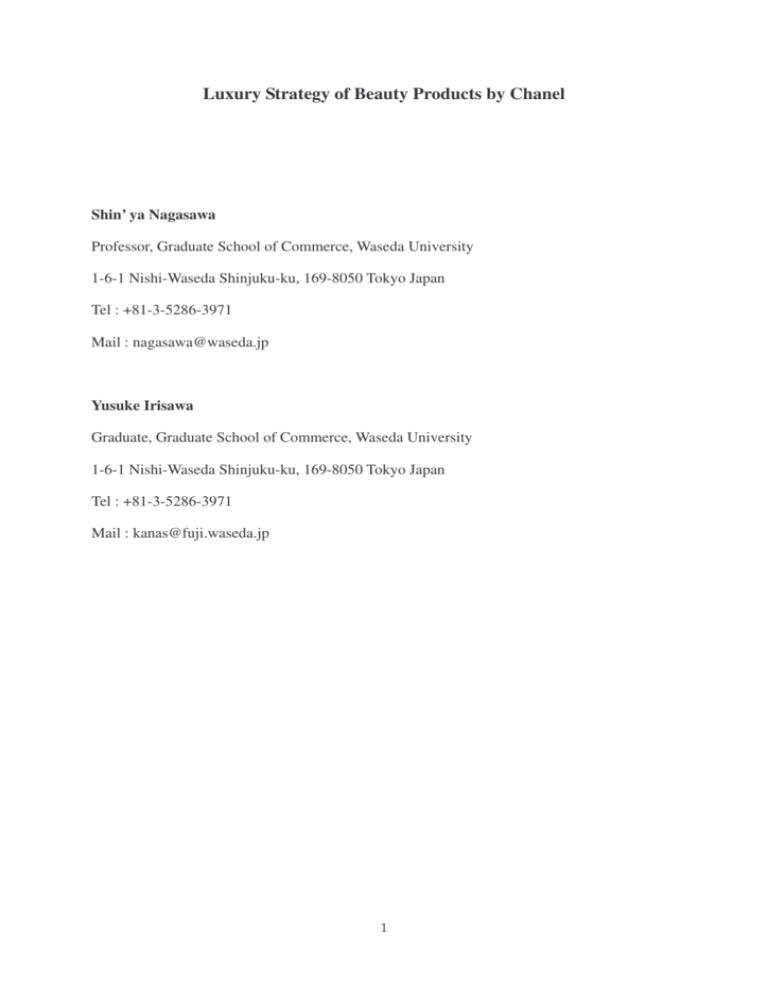
Luxury Strategy of Beauty Products by Chanel Shin’ ya Nagasawa Professor, Graduate School of Commerce, Waseda University 1-6-1 Nishi-Waseda Shinjuku-ku, 169-8050 Tokyo Japan Tel : +81-3-5286-3971 Mail : nagasawa@waseda.jp Yusuke Irisawa Graduate, Graduate School of Commerce, Waseda University 1-6-1 Nishi-Waseda Shinjuku-ku, 169-8050 Tokyo Japan Tel : +81-3-5286-3971 Mail : kanas@fuji.waseda.jp Luxury Strategy of Beauty Products by Chanel Abstract Objectives This study offers recommendations for the corporate management of most manufacturing companies. While it is true that no company can avoid relying on unstable business resources, such as its company "brand," consistent efforts over an extensive period are required to develop a powerful brand with long term prospects. However, any well-established brand can easily lose its positive image. Companies must respond appropriately to rapid changes in the market, including consumption patterns, consumer trends, and technological developments. Methods This study focuses on a top luxury brand, Chanel, as a model company for both its sustained efforts and appropriate responses to market changes. We had a literature survey of the company. According to the survey, we analyze the succession of technology and production of the technology management brand of Chanel. Results The findings show that Chanel's approach of achieving its a targets through the application of basic business resources, such as through its corporate philosophy, human resources, organization, and the succession of technology and skills, has enabled it to maintain its position as a top luxury brand since the company was established. The conclusions of this study have implications for the management of traditional manufacturing companies. Conclusions This paper views Chanel as a technology management company, in order to distinguish its characteristics. Technology management refers to business management conducted around sophisticated technological expertise. Although Chanel was a latecomer to the cosmetic business, Chanel's commitment to technology and innovation is apparent in the establishment of its own laboratory. Chanel's commitment to technology are considered through the example of its cosmetics. Keyword : Luxury Brand, Brand Management, Luxury Product, Beauty Products, Chanel 1. Introduction Chanel’s beauty products boast superior standards in terms of both packaging and quality. They are far better than the level one would expect from a fashion brand that has branched out into beauty products as a side business. Asked about the factors that helped Chanel achieve its sales target in the Japanese market in 2005, Richard Collasse, the president of Chanel’s subsidiary in Japan, replied as follows, a remark that sums up Chanel’s corporate philosophy. “Chanel has three business areas: fashion, fragrance and beauty products, watches and jewelry under the single brand name. We have been focusing efforts to specialize in the respective areas, instead of pursuing them as side businesses of the fashion segment.” [1] Peter J. McHale, vice president of Research & Development in the U.S., says that Chanel thinks it is important to have a long-term vision and achieve long-term success, a commitment visible throughout the organization [2]. Chanel takes time to develop products in a new business area and ultimately becomes one of the top players in the industry. Chanel does not start up a new business in a short period of time by taking advantage of its brand name and through much publicity. Precisely because Chanel focuses on establishing technologies based on a long-term vision, the company can expect to benefit from various cumulative effects. This management style is time consuming and may be out of tune with contemporary business practices that emphasize speed. However, once the company is established, wins the trust of its customers, and starts generating profit, it continues to do so over a long period of time. The same scenario applies to the fragrance and watch segments. The company steadily establishes an in-house supply system covering the entire value chain from the purchase of materials and research and development to manufacturing and distribution, a strategy that helps enhance the company’s presence in the market. It is often said that beauty products appeal to the emotions and customers tend to choose based on product image. That is why many cosmetics companies emphasize creating particular images for their products. In contrast, Chanel places as much importance on quality and the company has achieved a competitive edge through this Spartan approach. This paper examines Chanel’s emphasis of technologies in the beauty product segment and the innovations that have resulted from it. Beauty products are roughly divided into two types – skincare products, such as toner, moisturizing lotion, and beauty essence, and makeup products, including foundation, eye shadow, and lipstick. It is amazing to see how Chanel, which originally started as a fashion house, devotes so much energy and resources to the development of skincare products. It may be no exaggeration to say that Chanel’s role as a technology-oriented company, the gist of this paper, is embodied in the beauty products segment. 2. Skincare products Since around 1999, major European fashion brands started to direct more efforts towards skincare products. Until then, most of them were focused on fragrance and makeup products, such as mascara and lipsticks. Compared to makeup products, skincare products are used more frequently, and it is easier to make customers buy higher-priced skincare products more often and to increase sales. Until that time, the majority of skincare products on the Japanese market were manufactured by domestic brands or foreign cosmetics companies [3]. Capitalizing on public recognition of their brand, fashion brands, including Christian Dior affiliated with LVMH group, Yves Saint Laurent, a subsidiary of PPR Group, and Sonia Rykiel, an independent fashion house, started to offer skincare products. Of these skincare products, Chanel products are the only ones created by a fashion brand that have continued to enjoy a significant market share over time. As indicated in the remark made by Collasse, the president of Chanel Japan, the policy of specialization in a particular area seems to have resulted in this longevity. 3. Makeup products and relevant facilities The history of Chanel’s makeup products began in the 1920’s with the creation of the world’s first lipstick to satisfy Coco Chanel’s own needs. Makeup products created for both beauty and practicality are the foundation of the evolution of Chanel’s beauty product business. In the ensuing years, Chanel came up with star products, including eye shadows and cheek power, in addition to lipsticks. Creativity and technologies are integrated into Chanel’s makeup products. For creativity, discussion is not necessary here, as cosmetics magazines and various detailed materials are available for the public to read. This paper will examine “technologies,” focusing on technologies that make use of “light,” a keyword for Chanel’s makeup products. (1) Case study 1: Makeup techniques Creators at Chanel stress the importance of transforming ideas into commercial products. They recognize that products are the fruits of technologies. Some products are released into the market after as many as 15 years of development [4]. Heavily applied foundation does not last long. Coco Chanel came up with a makeup technique to make the face glow, instead of heavy application of the foundation. Dominique Moncourtois, who joined Chanel in 1969 at the invitation of Coco and retired in 2008, and Heidi Morawetz, who joined the company in 1980, teamed up and in 1982 created color and light effects that were previously unknown, using a luminous pigment technique. The two creators wanted the skin to glow from within, instead of superficial and temporary beauty created by heavy application of the makeup, and successfully commercialized the abstract idea that Coco had entertained. True to the tradition at Chanel, they were inspired by Coco’s desire for people to see the substance, not the surface, and combined it with technologies for the innovation, just as the company had done at the time of the creation of Chanel No. 5 perfume. Of course, Chanel also went to great lengths to create a quality container, which will be touched upon later. (2) Case study 2: Mirror stands in shops Mirror stands installed in shops illustrate Chanel’s particular use of light not only in its products but also in showing how customers look. The mirror developed under the initiative of Dominique Moncourtois, Chanel’s makeup creation director, has light-emitting diodes embedded in the rim. Five types of light, including day light, natural light, fluorescent light, and candlelight, can be switched on with the touch of a button. Mirroir Lumière means light mirror in French, and Chanel has obtained a patent on it [5]. The mirror stand allows users to change their makeup to suit the light at a particular time of day. For instance, the same makeup looks completely different at dusk and under a fluorescent light. Bags under the eyes may be unnoticeable in the morning light just after makeup is freshly applied. The mirror stand can show how they will look in the late afternoon light, and shop attendants can make suggestions to customers on how they can prevent an unfavorable change in their look likely to appear with the passage of time. This mirror stand enables customers to try the best makeup method for different occasions and find out its effect. The first mirror stand of this type was installed in Isetan Department Store in Tokyo’s Shinjuku district in 2001 [6]. Chanel’s choice of installing the very first equipment in Japan ahead of France points to the importance the company attaches to the Japanese market. That should be notable. Selling products to customers by disclosing risk and how to deal with it ultimately helps win customer satisfaction and trust in the long run. This method of selling beauty products is time consuming and costly, as the mirror stand has to be installed and tended by the staff. Chanel has opted to spend time and money for greater gain, the same strategy as that adopted in its other segments, and this approach has propelled the company to where it is now. (3) Case study 3: Ceiling light in department stores Chanel also invented a device to use the light under difficult environments to optimize the color and texture of its products. In the Makeup Studio opened in the Ginza branch of Matsuya Department Store in Tokyo, a lighting system developed by Chanel was adopted for lighting of the ceiling. Named Technical Ceiling, the polarizing system ensures that every part of the shop gets sufficient light, and no light is blocked even if people are standing behind customers [7]. Even high quality beauty products cannot demonstrate their texture or color to the fullest in department stores with various restrictive factors. Chanel used the light in a creative manner to resolve this problem. Department stores are tied down to various restrictions with regard to shop space. Even Chanel must have had difficulty trying to customize the lighting system. Chanel proved itself once again by obtaining approval to customize lighting through tenacious negotiation in order to provide not just beauty products but the entire presentation platform for makeup. Even in marketing devices such as relevant facilities Chanel makes efforts to enable customers to have better experience of the effect of its beauty products, by optimally using the light. Of course, other brands also direct efforts to bring out the best in their products. However, not all the companies possess devotion to and the technology necessary for the in-house development of marketing devices. Because Chanel has a proven record and expertise in technologies in various areas, it can pursue “Management of Technology (management making the most of technology)”. The underlying principle of the technologies is Coco Chanel’s philosophy that everything Chanel offers is designed to bring out the best in Chanel users, as we had repeatedly mentioned. (4) Case study 4: Mirrors with light adjustment function CHANEL AOYAMA, Chanel’s first ever free-standing store specializing in beauty products and fragrance that opened in 2009, also features an innovative technology for light. The shop is divided into three zones – the makeup zone with white as the theme color, the fragrance zone in black, and the skincare zone with beige as the theme color. These three are the colors of Chanel. In the white-based makeup zone, a large full-length mirror is placed against the wall so that the customer can check her makeup in relation to the rest of her body. But that is not all. Lighting as well as the size of the mirror makes a difference when a customer checks how well makeup is applied. Chanel adopted a special material made from glass for the wall surface, which softens harsh fluorescent light [8]. Thanks to a white fiber-like material mixed with glass, you don’t get fatigued from looking at the large mirror reflecting fluorescent lights for a long time. This is another example of the use of light to create distinctive products and services. Photo 1 Event for rouge COCO launch in CHANEL AOYAMA: (photo taken by the author in March, 2010) 4. Strategy for the Japanese market Japanese women are known to be extremely beauty conscious and have profound knowledge and passion for beauty products. Foreign cosmetics brands are eager to gain a foothold in this challenging Japanese market. Chanel eagerly directs efforts not only in the marketing segment but also in the technological aspect. Nowadays it is not unusual for a foreign company to have a research laboratory in Japan or to localize a complete range of products for the Japanese and other Asian markets. Not so long ago, however, many foreign companies still sold in Japan and the rest of Asia the products they had created for their home market, with no or little localization. Some Japanese consumers complained that foreign brand products with stronger fragrance and ingredients do not suit their skin. It is not surprising, given that Westerners and Japanese have different skins and preferences. Even though the situation has changed now, some consumers still have the same reservation towards beauty products made by foreign brands. Against such a background, a growing number of companies develop products exclusively for the Japanese market, in view of the size of the Japanese market full of savvy consumers. Chanel is one of the frontrunners in this movement. Chanel’s mainstay business is fashion, not beauty products. And yet, the company has gone so far as to establish a laboratory in Japan, a point also stressed by sales personnel in sales talks. Ask any Chanel sales consultant, “What is the characteristic of Chanel skincare products that distinguishes them from those of other companies?” They would say, “Chanel has a laboratory in Japan to develop products especially for knowledgeable Japanese customers. That is our defining feature and strength.” The same thing is stated in product catalogues. The company has a policy of developing products in Japan, as it is vital for the company to create products that satisfy Japanese consumers, who are the most knowledgeable about beauty products in the world. Various officers and employees, site staff, and customer service personnel of Chanel all make similar remarks. The author asked a similar question to several other brands. No company mentioned the existence of a laboratory in Japan first. Chanel’s catalogue “CHANEL PRÉCISION Skincare Chart” featuring the line-up of its skincare products and their characteristics in chart format has the following passage. “Take the ‘Précision’ series of skincare products; Chanel Research & Technology has R&D facilities in Europe, the U.S., and Asia to conduct research and development of products which meet the needs of contemporary women, based on dermatology and cosmetics research. The Précision series is a luxury skincare line for healthy and beautiful skin, taking into account the effects of various environmental factors on the skin.” (Translation) There are three different lines for different purposes in the series. The “Whitening Care” line for whitening effects has been developed exclusively for the Asian market, with the skin characteristics of Japanese women in mind. (Chanel’s catalogue of cosmetics) Being such a renowned brand, Chanel could have partnered with a variety of large and small Japanese cosmetic manufacturers for license production or OEM. However, Chanel actually opted to establish a research and development institute for beauty products in Japan in order to enter the Japanese market. Chanel’s honest and almost rigorous strategy exemplifies the company’s dedication and is simply remarkable. 5. Global research institutes As noted earlier, Chanel’s beauty products segment comprises the makeup and the skincare divisions. Technological prowess is called for in the skincare products, as they cannot rely on images and concepts only. Although Chanel is primarily known as a fashion brand, it has its own research institute to conduct basic and applied research to incorporate the results of research into product development. This is further evidence of Chanel’s painstaking approach to technology. Peter J. McHale stresses that product-making is conducted under the instructions of top management, who encourage the staff to incorporate selected research results and take advantage of science to the greatest possible extent. Chanel creates products based on research results, especially in the skincare segment. Centre de Recherches et d’Investigations Épidermiques et Sensorielles (CE.R.I.E.S), skin and sense investigation center, was established in Neuilly, France in 1991 to specialize in skin-related research. The “Précision” series of skincare products is now one of Chanel’s best-selling products, and was released after eight years of research there as a long-term project. CE.R.I.E.S is headed by Dr. Erwin Tschachier, a professor at the Medical University of Vienna, Austria, and its board includes professors of prestigious universities from throughout the world. The President is appointed every two years, in order to promote innovation and nurture new talent. CE.R.I.E.S partners with academia in order to improve research through such collaboration [9]. Under the slogan of “Laboratory without Walls,” it encourages all staff members engaged in research on the skin, including scientists, dermatologists, and clinical doctors, to carry out research by communicating with each other across divisions and nationalities [10]. CE.R.I.E.S provides financial assistance as part of its research activities. An annual award has been offered since 1996, with a Japanese researcher receiving the first award [11]. Another Japanese researcher won the award in 2005. Award winners receive 40,000 Euro (approximately 52,000 U.S. Dollar) in prize money. Chanel has five research institutes in three countries, including Neuilly and two others in France, the location of its head office. The other two are an institute in Piscataway in New Jersey, the U.S., which was founded after World War II, and Chanel Cosmetics Technology Development Institute, which was established in 2003 in Funabashi in Chiba Prefecture, Japan. Basic research as well as product development is conducted at the Funabashi institute. The fact that Chanel carries out research and development at its own laboratory in Japan is not widely known to the public. 6. Research institute in Japan As stated earlier, Chanel has a research institute in Japan, which is unusual for a foreign cosmetics brand. Chanel Cosmetics Technology Development Institute was opened in November, 2003 in Funabashi City in Chiba Prefecture at the building cost of approximately 2.5 billion yen [12]. Photo shows Chanel Corporate Operations Center, Funabashi, including a cosmetics technology development institute. Photo 2 Chanel Corporate Operations Center, Funabashi: A building complex housing three functions, including a cosmetics technology development Institute, a training center, and a distribution center (photo taken by the author in July, 2008) The six-story building on a lot of about 13,400-square-meters is also used as a distribution center and a training center. The magnificent building’s exterior and interior are in Chanel’s company colors of white, black, and beige. Far from a regular company canteen, Café Cinq on the fourth floor is a trendy restaurant. Cinq is five in French, and was named after Chanel No. 5 fragrance. The institute was opened with a view to developing products that suit the Japanese skin in Japan, a key market for Chanel, and to absorbing superior cosmetics development technologies in Japan, according to the Company Sites Navigation – Lively Companies Located in Chiba Website offered by Investment Promotion Division of Chiba prefectural government [13]. The institute mainly conducts research into raw materials and basic components for beauty products and how to combine them, in cooperation with its counterparts in France and the U.S., as needed [14]. Japan is different from Europe and the U.S. in terms of climate and consumer preferences. That is why it is important to develop products for Japanese customers in Japan. Chanel stresses offering products which may have different features from those sold in France but which are pleasing to particular users. Such corporate philosophy led to the establishment of the research institute in Japan. French consumers generally care little about the whitening effect of beauty products. Hardly any whitening technologies are found in France. Chanel’s “Blanc Essentiel” whitening series was developed in its research institute in Japan. Following in the footsteps of the Japanese, women from South Korea and Taiwan increasingly use whitening products. Japanese women are known to have strong desire for whiter skin tones, and many cosmetics makers concentrate efforts on this line of business. Compared to European women, Japanese are more prone to pigmentation. Chanel has been conducting research into pigmentation of the Asian skin for many years at its research institute in Japan, with Japanese researchers playing a central role, in cooperation with its counterparts in France and the U.S. Cleansing has also been developed especially for water quality in Japan and the Japanese skin, while lotions are concocted under the guidance of Japanese researchers to suit the Japanese sensory evaluations. These are examples of Chanel’s painstaking localization efforts [15]. Nobuhiro Ando, head of Chanel Cosmetics Technology Development Institute, mentioned a plan to conduct research into the relationship between cosmetics and life style, saying such research will be truly suitable for Chanel. He emphasizes the importance of combining technologies and the brand philosophy [16]. Similar to other business operations, research and development is also conducted on a long-term basis in principle. Lead time of skincare products is very long at Chanel. The company is aware that consumers do not expect skincare products to have an instant result like fragrance or makeup products and that consumers purchase Chanel products because of their trust in the company. Chanel places great importance on consumer trust [17]. Another salient feature of Chanel Funabashi Corporate Operations Center is its extensive involvement in the local community. Chanel’s warehouse in Tsukishima in eastern Tokyo was not large enough for its growing business and the company was looking for an alternative facility, when it stumbled upon the building in Funabashi. Behind the decision to move to the present location was eagerness and cooperation of Chiba prefectural government, according to Chiba Prefecture Business Environment Information website created by Japan External Trade Organization (JETRO) [18]. As Funabashi and the French luxury goods brand seemed a world apart, local residents were skeptical that Chanel would actually move to Funabashi. The company now organizes an event for local elementary school pupils so they can have a first-hand look at Chanel’s beauty products, partially sponsors a fireworks event during summer holidays, and employs local handicapped people. Café Cinq, the staff canteen mentioned above, also uses a variety of local produce, particularly vegetables in Funabashi City or Chiba Prefecture [19]. Chiba prefectural government is very eager to attract foreign companies and actively provides assistance. In response, President Collasse also introduces companies considering relocation to Chiba Prefecture. A renowned foreign company like Chanel greatly contributes to a locality in terms of employment, tax revenue, and improving the image of the locality [20]. 7. Communication tools Chanel makes optimal use of unique tools to communicate the value of its products to customers. This section examines four of them in detail. (1) Counseling by beauty advisors (BA) As illustrated above, Chanel’s beauty products business does not rely only on its brand name, but possesses true quality achieved through the company’s Spartan approach. However, as is often the case with branded goods companies with strong marketing power, consumers often overlook the essence of Chanel’s skincare business. They are not aware that the desire to invent products that are really good for the skin is driving Chanel to conduct research and development at its own laboratory. Since its dedication toward research and development in the skincare business is not as well known as that for fragrance or handbags, it is vital to have communication tools with consumers. Counseling by beauty advisors is available at cosmetics corners across Japan. The advisors conduct skin analysis and help consumers choose products suitable for their skin. Beauty advisors who serve customers undergo training on Chanel products at the Funabashi training center mentioned above. There are no part-timers, as is the case with other cosmetics brands. The author and associates visited a dozen cosmetics counters across Tokyo and were impressed with beauty advisors’ answers to detailed questions about products as well as desired results and their responses to our requests offering as samples. None of them at any of the stores we visited was arrogant or showed excessive salesmanship. We confirmed that, to a large extent, sales personnel practiced what was preached in interviews by Nobuhiro Ando, head of Chanel Cosmetics Technology Development Institute. Beauty advisors were able to give satisfactory replies to technical questions regarding R&D and raw materials, highlighting the merits of Chanel products. It should be noted that the ability to provide convincing explanation is not limited to the cosmetics segment. Even though the questions asked by the author and the associates were overly technical, it was apparent that Chanel’s sales personnel used technical explanation to persuade prospective customers to buy. What is unique about Chanel is that beauty advice in the shop is provided on the basis of questioning by highly-trained beauty advisors and a “diagnostic tool” specially developed for identifying skin types [21]. Such a diagnostic tool and highly-skilled human resources make it possible to accurately cater to the needs of each customer, not of the collective masses, thereby differentiating Chanel from its competitors. Steady efforts have paid off, and Chanel’s skincare products are increasingly recognized in the market. Chanel revealed that the perception of its brand in the Japanese market improved dramatically in 2006 according to a survey of its position in the Japanese market conducted by the company every three years. Chanel was ranked top as the company whose skincare products improved notably and reached second place in terms of product value. Such an improved image is reflected in sales. Sales of Chanel’s skincare products rose to fourth place thanks to the whitening line developed especially for the Japanese market, in contrast to eighth or ninth place among foreign cosmetics manufacturers in 2000 [22]. The effect of skincare products is hard to fabricate, and Chanel’s efforts to improve public perception of its skincare products are gradually bearing fruit. The percentage of skincare products in the overall sales of beauty products rose from some 20% in 2000 according to the Nikkei Marketing Journal [23] to almost 30% in 2007, in line with the target set by the company. Almost 10 years have passed since the renewal of Chanel’s product lineup. The company is now known as Chanel for skincare, in addition to Chanel for cosmetics, thanks to the opening of its training facility of sales personnel and other steady initiatives. (2) Customer relationship management (CRM) Communication with customers through the diagnosis of skin conditions is not the only thing Chanel does to make customers understand the emphasis the company places on its skincare products. The company has been centering efforts on customer relationship management since 2006 under the slogan “Customers First,” an unusual policy for a luxury brand. Chanel’s efforts consist of conservative and steady activities. For instance, the company sends out postcards that entitle customers who have purchased Chanel products worth a certain amount to a complimentary gift once a year. A customer bringing the postcard to any Chanel counter can receive a gift without buying anything. To make the best use of such visits, Chanel checks the customer’s purchase history using a customer relationship management system and recommends the most appropriate products to her. By creating this mechanism, Chanel saw the percentage of customers who bought a Chanel product when bringing the postcard to the counter increase to 70% from 54% before the CRM system was introduced. The use of CRM enables the company to grasp the particular needs of the customer and to make appropriate product recommendations, generating sales. Sales are on the increase, while the company has also cut down on sending out unnecessary direct mail and reduced unnecessary services [24]. (3) Development of sampling device: blotter and Olfactive Bar There is another communication tool designed to demonstrate the true value of Chanel products to customers. This time, it is not for cosmetics but for fragrance. There is another communication tool designed to demonstrate the true value of Chanel products to customers. This time, it is not for cosmetics but for fragrance. Smelling strips are usually used for sampling perfumes. Several different fragrances can be sampled in this way without being applied directly to the skin. Smelling strips are suitable for sampling the top note, the scent that appears instantly. However, smelling strips cannot be used to test the middle note, which appears after a while. Sampling is also limited to several kinds, as different scents are mixed up in the air. Respecting Coco’s insistence on lasting beauty from the beginning until the end, Chanel invented an optimal tool for helping customers choose perfume. Blotters are off-white sticks made of ceramic with aroma essence applied to the tip. Since ceramic gives off scent more slowly than paper and the essence is applied in advance, customers can sample the middle note without waiting for hours. Photo 3 “Olfactive Bar” for fragrance tasting at CHANEL Aoyama Sticks are stored in test tubes that are housed in the Olfactive Bar where all Chanel’s fragrances are grouped into nine categories. Scent lasts for 10 days in test tubes. No scent remains after sticks are put back in the tubes. That is why customers can take as long as they want until they find a particular scent they like. This is a big advantage, compared to paper. Staff members who have received special training on perfumes choose blotters for customers, referring to specific and sometimes abstract key words, such as their favorite flowers, colors, and adjectives. The process of choosing a perfume with technical explanations regarding the manufacturing process, raw materials, place of origin, and themes, which are all neatly filed, looks more like a scientific experiment. Coco Chanel regarded perfume as something like medicine; she emphasized the effect of fragrance, its lasting effect, and the importance of change. She wanted customers to actually smell and apply perfume, and experience the change. That is why these devices and the shop space were created. The Olfactive Bar is the first such equipment in the world, and in all of Japan, sampling of fragrances using the blotter is available only at Chanel Aoyama. In addition to product quality and packaging, Chanel is also committed to making the pre-sale experience as much fun and as informative as possible. 8. Packaging As touched upon in another dissertation, Chanel also pays meticulous attention to the packaging of its beauty products to convey their value. This chapter looks at three examples. (1) Unified packaging worldwide Since its foundation, Chanel has hardly changed the packaging of its products in its signature colors of black and white. Just like its long-selling items with a longer history, such as fragrance and handbags, its beauty products have kept the core part intact, with only minor improvements. Chanel’s beauty products are sold around the world and the company has gone great lengths to ensure the unified appearance of its packaging. Chanel started to overhaul its packaging around 2000. At that time, there were small differences between the packages of products manufactured in France and those made in the U.S. Determined to give the identical look regardless of where its products are purchased, Chanel spent almost four years unifying the appearance of its packages around the world. As a result, the same package is available for over 95% of its beauty products across the world. Gene Berlanti, the then senior vice president of operations, admitted in an interview that unification was a very difficult task [25]. Similar to the renewal of the packaging of its No. 5 perfume, Chanel harmonized and globalized its beauty products, with a view to avoiding confusion among its customers. Several sales personnel interviewed asserted that the packages of Chanel products enjoy a unified appearance of color and shape and do not look clattered in the room (according to the interviews to Chanel Boutique staffs conducted by the authors). (2) Use of new materials The packages of Chanel’s cosmetics products were made of Bakelite, a new material adopted for use in the auto industry in 1932. Coco Chanel emphasized the importance of both beauty and practicality and designed packages that can be carried around [26]. The Chanel founder, who created the little black dress that Vogue magazine called a Ford, created the packaging of beauty products using a material for automobiles. Subsequently, improvement was made to ensure no alteration of the surface. Bakelite is a thermosetting resin and known for its heat- and flame-resistance. It is also oil- and chemical-proof. In addition to long-lasting makeup products as basic items, Chanel is dedicated to offering quality in everything related to beauty products, such as functional and easy-to-use brushes and mirrors. (3) Packages oozing a luxury feel The Rouge Allure series of lipsticks released in 2006 epitomizes Chanel’s meticulous attention to packaging and its technological prowess. A lipstick is usually opened with one hand holding the tube while the other hand removes the cap. With the Rouge Allures series, the lipstick pops up by just one click. Dominique Moncourtois, one of the creative duo mentioned earlier and who was more in charge of technological aspects [27], revealed the background of its development in an interview. Photo 4 Package of Chanel’s Rouge Allure “The sound of a click was modeled on the opening and closing sound of the door of a luxury car or the sound one makes when walking over a thick carpet. Lipsticks are usually a first item that consumers purchase in a luxury line. That is why it is important to have packaging that retains a luxury feel from day one until the last day of its use. The black body reminiscent of a black robe, the sound, metallic scent, the texture, and the taste of lipstick are all combined to tantalize the senses, making every woman want to carry it around. [28]” (Translation) Based on this concept, Chanel created the scratch-proof series. The metal part was lacquer-finished with additional coating thanks to cooperation from a Japanese company [29]. Every time he comes to Japan, Dominique Moncourtois visits Japanese manufacturers and artisans for new materials or pigment. The author took a close look at a Rouge Allure lipstick belonging to a friend, who had carried it around in a bag for some three months. No scratch was visible, in contrast to scratches and discoloring usually found on lipsticks of many other brands after they are carried around in a bag pocket for a couple of months. It is not easy to carry out his words, “retain the luxury feel from day one until the last day of use.” This epitomizes Chanel’s pursuit of technologies for solving problems and commercialization [30]. 9. Conclusion The findings show that Chanel's approach of achieving its a targets through the application of basic business resources, such as through its corporate philosophy, human resources, organization, and the succession of technology and skills, has enabled it to maintain its position as a top luxury brand since the company was established. The conclusions of this study have implications for the management of traditional manufacturing companies. This paper views Chanel as a technology management company, in order to distinguish its characteristics. Technology management refers to business management conducted around sophisticated technological expertise. Although Chanel was a latecomer to the cosmetic business, Chanel's commitment to technology and innovation is apparent in the establishment of its own laboratory. Chanel's commitments to technology are considered through the example of its cosmetics as follows: (1) Skincare products (2) Makeup products and relevant facilities: makeup techniques, mirror stands in shops, ceiling light in department stores, mirrors with light adjustment function (3) Strategy for the Japanese market: (4) Global research institutes: (5) Research institute in Japan (6) Communication tools: counseling by beauty advisors (BA), customer relationship management (CRM), development of sampling device (blotter and Olfactive Bar) (7) Packaging: unified packaging worldwide, use of new materials, packages oozing a luxury feel References [1] Nikkei MJ, June 26, 2006 (in Japanese) [2] Herlihy, Janet, CHANEL 2004 Company of the Year: Excellence in Packaging, Beauty Packaging Magazine, January/February 2005 [3] Nihon Keizai Shimbun, August 18, 1999 (in Japanese) [4] Bott, Daniele, Chanel: Collections and Creations, Thames & Hudson, 2007 (Mariko Takahashi trans., Kodansha, 2007, p.146 (Translated in Japanese)) [5] Tenjin Keizai Shimbun, June 20, 2008 http://tenjin.keizai.biz/headline/1613/ (in Japanese) [6] Nihon Keizai Shimbun, September 4, 2001 (in Japanese) [7] Nikkei MJ, December 7, 2005 (in Japanese) [8] OKALUX Co. Website http://www.okalux.de/en/references/all/kapilux/vorlage.html?0= (in Japanese) [9] Plaza for industry-University cooperation Website http://www.sangakuplaza.jp/page/ 171322 (in Japanese) [10] COMPLEMENTS OF CHANEL Website http://uma.chanel.com/research.php [11] CE.R.I.E.S. Website http://www. ceries.com/prixrecherche.htm [12] Nihon Keizai Shimbun, October 2, 2003, an evening edition (in Japanese) [13] The Company Sites Navigation – Lively Companies Located in Chiba, Website offered by Investment Promotion Division of Chiba prefectural government http://www.pref. chiba.lg.jp/syozoku/f_rich/genkikigyou/chanel/ (in Japanese) [14] Ando, Nobuhiro, Research and Development for whitening products in cooperation with Chanel’s global counterpart, Fragrance Journal, No.5, pp. 13-15, 2005 (in Japanese) [15] Ando, Nobuhiro, ibid., 2005 [16] Ando, Nobuhiro, ibid., 2005 [17] Janet Herlihy, ibid., 2005 [18] Interviews to President Collasse and Ececutive Officer Goto, Managing Director of the headquarters of Chanel Japan, according to Chiba Prefecture Business Environment Information website created by Japan External Trade Organization (JETRO) http://www.jetro.go.jp/invest/region/icinfo/chiba/pdf/chiba% 20success% 20story.pdf (in Japanese) [19] Website offered by Investment Promotion Division of Chiba prefectural government, ibid. [20] Website created by JETRO, ibid. [21] Magazine House, Website of “Web Da Capo,” http://webdacapo.magazineworld.jp/ beauty/7547/ [22] Kokusai Shogyo (Global Business), April, 2007, pp.100-103 (in Japanese) [23] Nikkei MJ, August 19, 1999 (in Japanese) [24] Kokusai Shogyo, ibid. [25] Herlihy, Janet, ibid. [26] Bott, Daniele, ibid. (Mariko Takahashi trans., ibid., p.139) [27] Naughton, Julie, Ellen Groves, and, Molly Prior, "Cosmetics Creators Depart Chanel," WWD, Oct. 25, 2007, Vol. 194, Issue 88, p.9 [28] Nikkei MJ, July 19, 2006 (in Japanese) [29] Nikkei Marketing Journal, op. cit. [30] Nagasawa, S., (ed.) and K. Sugimoto, CHANEL Strategy – Management of the Ultimate Luxury Brand –, Toyo Keizai Shinposha, 2010 (in Japanese)
